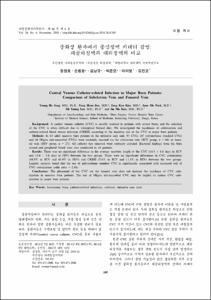KUMEL Repository
1. Journal Papers (연구논문)
1. School of Medicine (의과대학)
Dept. of Anesthesiology & Pain Medicine (마취통증의학)
중화상 환자에서 중심정맥 카테터 감염: 쇄골하정맥과 대퇴정맥의 비교
- Keimyung Author(s)
- Kim, Jin Mo; Lee, Mi Young
- Department
- Dept. of Anesthesiology & Pain Medicine (마취통증의학)
Dept. of Preventive Medicine (예방의학)
Institute for Medical Science (의과학연구소)
- Journal Title
- 대한중환자의학회지
- Issued Date
- 2011
- Volume
- 26
- Issue
- 4
- Abstract
- Background: A central venous catheter (CVC) is usually inserted in patients with severe burns and the selection
of the CVC is often difficult due to widespread burned skin. We investigated the incidences of colonization and
catheter-related blood stream infection (CRBSI) according to the insertion site of the CVC in major burn patients.
Methods: In 63 adult massive burn patients in the intensive care unit, 93 CVCs (47 polyurethane standard CVCs
and 46 Oligon anti-mocrobial CVCs) were randomly inserted via the subclavian vein (SCV group, n = 66) or femoral
vein (FEV group, n = 27). All catheter tips removed were routinely cultured. Bacterial findings from the burn
wound and peripheral blood were also monitored in all patients.
Results: There was no significant difference in the average insertion length of the CVC (14.3 ± 6.8 days in SCV
and 13.6 ± 3.8 days in FEV) between the two groups. There were no significant differences in CVC colonization
(48.5% in SCV and 63.0% in FEV) and CRBSI (7.6% in SCV and 11.1% in FEV) between the two groups.
Logistic analysis found that the use of polyurethane standard CVC is significantly associated with increased risk of
CVC colonization (odds ratio = 2.68).
Conclusions: The placement of the CVC via the femoral vein does not increase the incidence of CVC colonization
in massive burn patients. The use of Oligon anti-microbial CVC may be helpful to reduce CVC colonization
in major burn patients.
- Alternative Title
- Central Venous Catheter-related Infection in Major Burn Patients:
Comparison of Subclavian Vein and Femoral Vein
- Publisher
- School of Medicine
- Citation
- 장영호 et al. (2011). 중화상 환자에서 중심정맥 카테터 감염: 쇄골하정맥과 대퇴정맥의 비교. 대한중환자의학회지, 26(4), 245–249. doi: 10.4266/kjccm.2011.26.4.245
- Type
- Article
- ISSN
- 1229-4802
- 파일 목록
-
-
Download
 oak-bbb-3688.pdf
기타 데이터 / 261.96 kB / Adobe PDF
oak-bbb-3688.pdf
기타 데이터 / 261.96 kB / Adobe PDF
-
Items in Repository are protected by copyright, with all rights reserved, unless otherwise indicated.